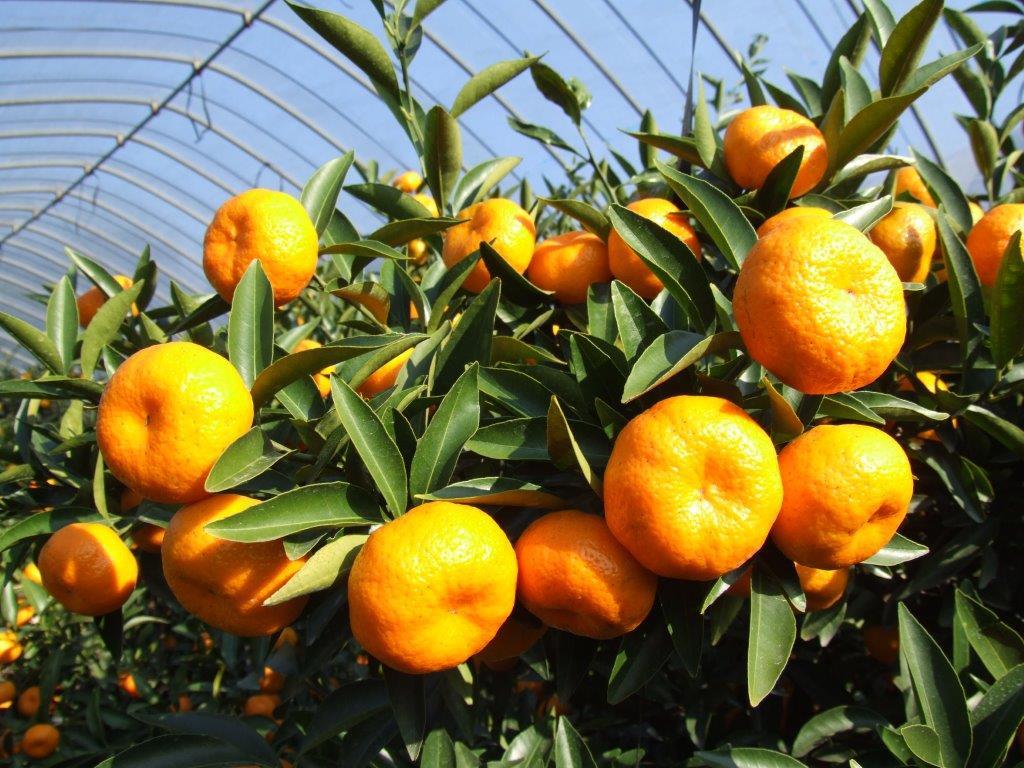Sakurajima komikan
| Registration Number | 46 |
|---|---|
| Name of the GI | Sakurajima komikan,Sakurajima ko-mikan |
| Class | Fruit |
| Date of Protection | 2017/11/10 |
| Producing Area | Kagoshima Prefecture |
| Applicant - Name and Address | Kagoshima Mirai Agricultural Cooperative, 27-17 Ogawacho, Kagoshima City, Kagoshima Prefecture |
"Sakurajima komikan" are "mikan" with extremely small fruit, grown on "Sakurajima (1)" in Kagoshima Prefecture.
Although the fruit is small, its flesh is tender and succulent. It is characterized by good flavor with nice balance of sweetness and acidity. The rind has fresh fragrance characteristic of citrus fruits, and is also used as a condiment.
"Sakurajima komikan" are harvested from late November to late December. Because the shipping volume is limited, they have a high scarcity value and are highly regarded by local market.
"Sakurajima komikan" are cultivated under "installed roof (2)" in order to manage moisture levels appropriately and to prevent damage from volcanic ash emitted from "Sakurajima", which is an active volcano.
Producers follow the "Sakurajima komikan shipping standard" and ship only well-formed fruit with few blemishes and/or insect damages. Even fruit that meets the "Sakurajima komikan shipping standard" cannot be shipped for fresh use if it has inferior external appearance, such as poor coloration. Instead, it can be used for processing.
"Komikan" have been cultivated from long ago on "Sakurajima", which is surrounded by ocean and is temperate and blessed by good sunlight all the year round. Literatures show that they have been cultivated since the Edo period (3). Trees over a century old can be found scattered around the production area.
In Kagoshima, the main consuming area, "Sakurajima komikan" are appreciated as one of few, locally-produced items for "oseibo (4)". Other than as food, they are also used for traditional decorations such as "shimenawa (5)" and "kagami mochi (6)". In sum, it is the product deeply embedded in local culture.
Although "komikan" have been produced since long ago, the contemporary method of cultivation was established in 1979, when "installed roofs" were introduced.
In 1983, the "Sakurajima Town Agricultural Cooperative" organized a new cargo-pickup and sales system, leading to the full-fledged development of structures to promote the production and sales. These structures continue to this day.
- Sakurajima: It is a peninsula in Kinko Bay (also known as Kagoshima Bay) in Kagoshima Prefecture. It was once an island, but lava flowing from a volcanic eruption in 1914 connected Sakurajima to the Osumi peninsula. The volcano is still active and has become a symbol of Kagoshima Prefecture.
- Installed roof: ordinarily, plastic greenhouses are wholly covered in plastic, but the hothouses found in temperate Kagoshima are built by covering only the roof section with plastic, basically as a countermeasure against falling volcanic ash.
- The Edo Period: 1603-1867. It is a period of Japanese history characterized by the establishment of a shogunate (feudal military government) in Edo (now Tokyo). Political administration under the Tokugawa clan began when Tokugawa Ieyasu became the era's first shogun.
- Oseibo: in Japan, people customarily give gifts twice a year to "express appreciation" to people who have looked after them. Summer gifts are called "ochugen", while year-end gifts are called "oseibo".
- Shimenawa: A traditional decoration made from braided straw with ornaments for the dual purposes of "facilitating the reception of the gods at New Year" and "preventing inauspicious spirits from entering one's home". The fronts of houses are adorned with these decorations at New Year.
- Kagami mochi: A traditional decoration used at New Year, just like "shimenawa". They generally consist of two flat mochi or rice cakes, with the smaller one placed atop the larger, and a "mikan" on top as a decoration.


